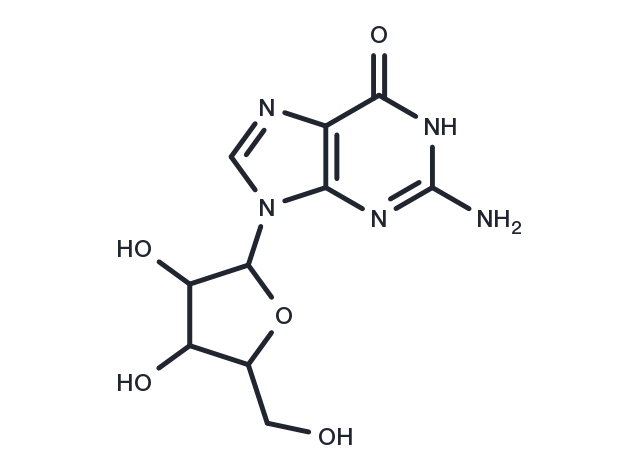Powder: -20°C for 3 years | In solvent: -80°C for 1 year


Guanosine (DL-Guanosine) is a purine nucleoside formed from a beta-N9-glycosidic bond between guanine and a ribose ring and is essential for metabolism.

| Pack Size | Availability | Price/USD | Quantity |
|---|---|---|---|
| 2 g | In stock | $ 30.00 | |
| 1 mL * 10 mM (in DMSO) | In stock | $ 30.00 |



| Description | Guanosine (DL-Guanosine) is a purine nucleoside formed from a beta-N9-glycosidic bond between guanine and a ribose ring and is essential for metabolism. |
| In vitro | Guanosine is a purine nucleoside comprising guanine attached to a ribose (ribofuranose) ring via a β-N9-glycosidic bond. Guanosine can be phosphorylated to become guanosine monophosphate (GMP), cyclic guanosine monophosphate (cGMP), guanosine diphosp |
| Kinase Assay | Tyrosine kinase assays: The tyrosine kinase activities are determined in 96-well ELISA plates precoated with 20 μg/mL Poly (Glu,Tyr)4:1. First, 80 μL of 5 μM ATP solution diluted in kinase reaction buffer (50 mM HEPES pH 7.4, 20 mM MgCl2, 0.1 mM MnCl2, 0.2 mM Na3VO4, 1 mM DTT) is added to each well. Various concentrations of AST-1306 diluted in 10 μL of 1% DMSO (v/v) are then added to each reaction well, with 1% DMSO (v/v) used as the negative control. Subsequently, the kinase reaction is initiated by the addition of purified tyrosine kinase proteins diluted in 10 μL of kinase reaction buffer solution. Experiments at each concentration are performed in duplicate. After incubation for 60 min at 37 °C, the plate is washed three times with phosphate buffered saline (PBS) containing 0.1% Tween 20 (T-PBS). Next, 100 μL anti-phosphotyrosine antibody (PY99, 1:500 dilution) diluted in T-PBS containing 5 mg/mL BSA is added. After 30 min incubation at 37 °C, the plate is washed three times as before. Horseradish peroxidase-conjugated goat anti-mouse IgG (100 μL) diluted 1:2000 in T-PBS containing 5 mg/mL BSA is added. The plate is reincubated at 37 °C for 30 min, and then washed with PBS. Finally, 100 μL of a solution containing 0.03 % Water2 and 2 mg/mL o-phenylenediamine in 0.1 M citrate buffer, pH 5.5, is added and samples are incubated at room temperature until color emerged. The reaction is terminated by the addition of 50 μL of 2 M H2SO4, and the plate is read using a multi-well spectrophotometer at 490 nm. The inhibition rate (%) is calculated using the following equation: [1-(A490 treated /A490 control)] ×100%. IC50 values are determined from the results of at least three independent tests and calculated by Logit method. |
| Source |
| Synonyms | DL-Guanosine, Vernine, Guanozin |
| Molecular Weight | 283.24 |
| Formula | C10H13N5O5 |
| CAS No. | 118-00-3 |
Powder: -20°C for 3 years | In solvent: -80°C for 1 year
H2O: < 1 mg/mL (insoluble or slightly soluble)
DMSO: 52 mg/mL (183.6 mM)
Ethanol: < 1 mg/mL (insoluble or slightly soluble)
You can also refer to dose conversion for different animals. More
bottom
Please see Inhibitor Handling Instructions for more frequently ask questions. Topics include: how to prepare stock solutions, how to store products, and cautions on cell-based assays & animal experiments, etc.
Guanosine 118-00-3 Metabolism Microbiology/Virology HSV Endogenous Metabolite Inhibitor DL-Guanosine Herpes simplex virus Vernine Guanozin inhibit inhibitor
